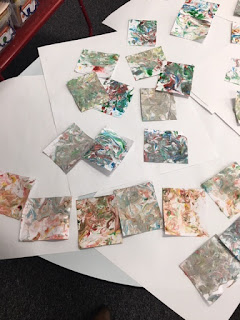Lesson Two: Balloons in Perspective
"In every job that must be done, there is an element of fun!" -Mary Poppins
My goal for teaching art to Mrs. Whipple's class this semester is to not only teach students about art types & techniques, but to keep it fun and exciting. Art is for everyone!
Before I start my review of today's lesson, I just wanted to share a thought that struck me today. When I walked into Mrs. Whipple's classroom, I could see the excitement of the students because they knew that we were working on art today. I arrived early, so I spent a couple minutes just observing the class and their morning routine. During this time, a few students came up to me and showed me drawings of mandalas that they had done this past week after I left. One student even showed me a mandala coloring/drawing book that she had gotten. I was touched that my lesson had had such an impact that they wanted to continue what we had done throughout their week. This tiny experience helped me understand that students do remember what you teach them and how you make them feel. Teachers have the responsibility for fostering whole-child development, not just cognitive learning. This comes from being enthusiastic and intentional in our instruction, not just lesson lecturers. As Fred Rogers said, "A love of learning has a lot to do with learning that we're loved."
This week we focused on perspective. 'Perspective' is a harder vocabulary word for second graders, so we spent some time defining what perspective is- it's how we see things based on where we are right now. Our perspectives can change when we move and our perspective can be different from someone else even if we are looking at the same thing. In the art world, artists use perspective to make things seem real. We looked at some examples to help solidify this concept:
Then, we added in more vocab pertaining to perspective: background, middle ground, and foreground. When we look at a work of art, the background is the part that seems farthest away, and usually is smallest in size. Middle ground is medium sized, and foreground objects seem closest to us because they are biggest. We went back through our examples to identify the background, foreground, and middle ground in each. Our assignment today was to create perspective by collaging hot air balloons on paper using construction paper. We looked at some examples and identified the balloons that were farthest and closest based on what we've learned about perspective. Then, students were able to create their own hot air balloons in perspective. First, they traced stencils of the three sizes of hot air balloons and cut them out. Then, they arranged them on their paper where they felt it would make sense with perspective, and identified the back/middle/foreground in their own work. Once they glued down their balloons, they added details such as the baskets, strings, clouds, and birds to make their work more unique and individualized. Even though each student was doing the same thing by making three hot air balloons, I still felt like each students' work was different because of how they arranged and decorated it. When I went around and asked the students which balloons where in which section of their paper, most could tell me. I was also very impressed in how some students kept the perspective of their paper even in their drawing of clouds. The bigger clouds were drawn by the biggest balloons (in the foreground) and the smaller clouds were drawn with the smaller balloons in the background.
I loved the detail that the students put into their balloon design. They didn't just cut out the circles, glue them down and call it good; they wanted to make it their own artwork. As we reviewed what we learned, it was evident that most of the students now grasped the idea of perspective & how it related to background, middle ground, and foreground. This discussion helped me realize that just because an activity is meant to be fun doesn't mean that learning isn't taking place.
**I've posted a link to my lesson plan for this week under the 'Resources' page of this blog.






Impressive- not only your project and lesson but the way you articulated it in your blog.
ReplyDeleteCan't wait to work with you. Vicki